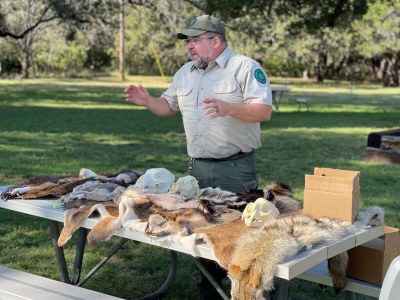Field Trips
Looking to get your students outside? Abilene State Park is the perfect outdoor classroom! We offer several ranger-led programs and guided hikes. 
Planning Your Field Trip
We lead field trips Tuesdays through Thursdays.
Plan to arrive at the park between 9 and 9:30 a.m.
Field trips may be cancelled if your group arrives more than 30 minutes late without contacting us.
How to Schedule
Call park reservations at (325) 572-3204 at least one month in advance. Please provide two preferred dates for the trip.
Costs
We waive entrance fees for students, teachers and chaperones.
Activities & Programs
Choose two of our ranger-led educational programs below or contact us for special requests.
The length of programs depends on the subject and time of arrival.
- Skins & Skulls – A program focusing on real skins and replica skulls of many of our native mammals. We discuss the adaptations these animals have developed to help them survive in their habitat.
- Applicable TEKS:
- 3.13(B) explore, illustrate, and compare life cycles in organisms such as beetles, crickets, radishes, or lima beans
- 5.13(A) analyze the structures and functions of different species to identify how organisms survive in the same environment
- Applicable TEKS:
- Birds of Prey – A program exhibiting two taxidermized birds and their adaptations. We discuss how our birds of prey survive from day to day and how their adaptations help them excel.
- Applicable TEKS:
- 3.12(C) describe how natural changes to the environment such as floods and droughts cause some organisms to thrive and others to perish or move to new locations
- 3.13(A) explore and explain how external structures and functions of animals such as the neck of a giraffe or webbed feet on a duck enable them to survive in their environment
- 5.13(A) analyze the structures and functions of different species to identify how organisms survive in the same environment
- Applicable TEKS:
- Guided Nature Hike – A hike along our Elm Creek Trail. Distance is determined by age group. Guides will stop several times along the way to point out interesting plants, animal tracks, ecological features, etc.
- Applicable TEKS:
- 1.12(A) classify living and nonliving things based upon whether they have basic needs and produce young
- 3.10(B) investigate and explain how soils such as sand and clay are formed by weathering of rock and by decomposition of plant and animal remains
- 5.12(A) observe and describe how a variety of organisms survive by interacting with biotic and abiotic factors in a healthy ecosystem
- Applicable TEKS:
